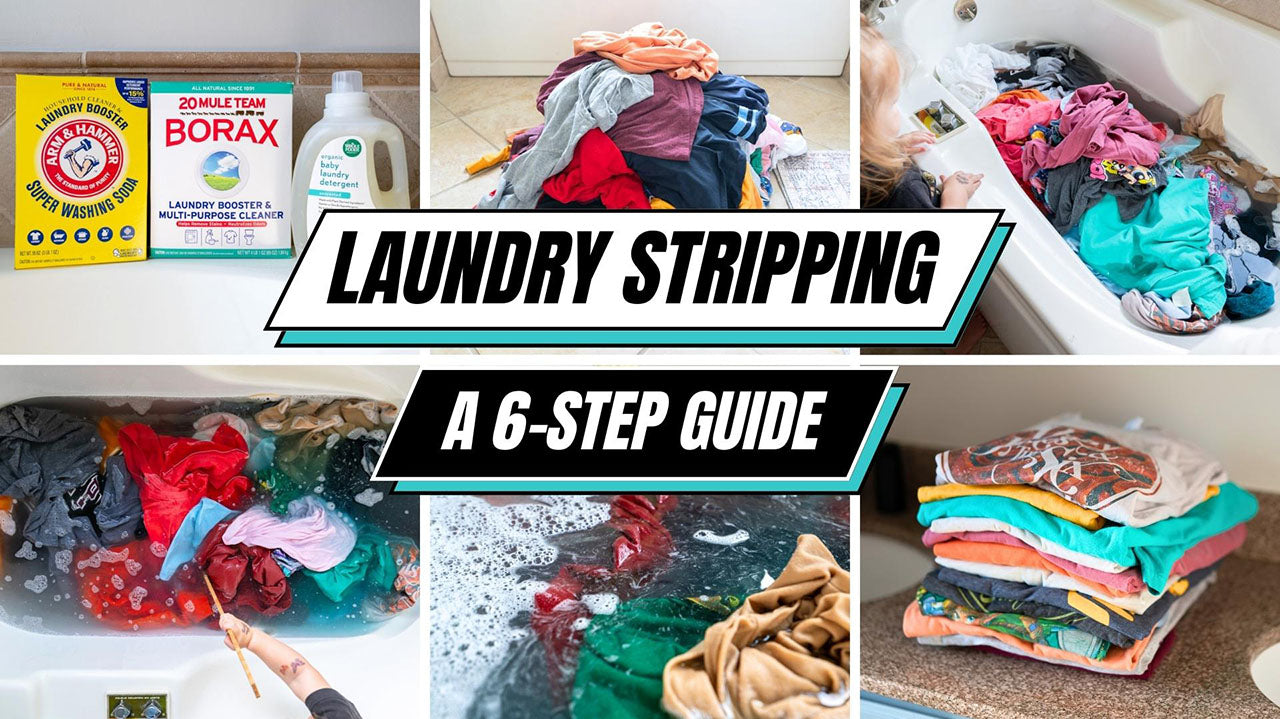Revive Your Old Clothes and Fabrics with Laundry Stripping in 6 Easy Steps

In this Article:
A second life, a fresh start, a hidden gem – that's what your old, dingy laundry could become with a simple yet powerful technique: laundry stripping. At JuneJuly, we know that beloved clothes and linens can lose their appeal due to unseen grime and laundry detergent build-up. But we believe in second chances - why not give one to your laundry too?
Laundry stripping is excellent for deep cleaning your own clothes, second-hand clothes, bed sheets, towels, and virtually any fabric that needs a refresh.
But what exactly is laundry stripping and why should you consider it?
In this article, we provide 6 easy steps to make it simple and straightforward, leaving your clothing and fabric vibrant and feeling as good as new.
What is laundry stripping?
Laundry stripping is a deep-cleaning process that removes accumulated grime, oils, and residual detergent or fabric softener from clothes and fabrics. It's excellent for refreshing old clothes, second-hand clothes, bed sheets, towels, and virtually any fabric that needs a revival.
Is laundry stripping safe?
Laundry stripping can be a safe and effective method for deep-cleaning durable, colorfast fabrics that can withstand high temperatures. It is not advisable for delicate garments and fabrics, items that might shrink, or non-colorfast items that could fade.
Also, natural fibers might weaken with this process. As always, it's important to respect the care tags on your items before deciding to strip laundry. Sturdy whites, off-whites, light colors, and colorfast bath towels and bed sheets typically respond well to the process. For those special pieces that need a gentler touch, stick to good hand-washing techniques to keep them clean and in their best shape.
Can laundry stripping fade your clothes?
Laundry stripping is generally a beneficial method for reviving and deeply cleaning sturdy fabrics, yet it may cause fading in non-colorfast or delicate items. So, it's important to know your clothes' specific needs.
Non-colorfast or delicate fabrics might experience some dye leaching due to the heat and deep-cleaning stripping process. I would always recommend checking the care instructions on your clothes before starting. If your items can handle a hot water soak, they're likely just fine!
Always be sure to sort your clothes by color, like you would when washing, before laundry stripping. This can ensure any color leeching does not affect other items.
What are the benefits of laundry stripping?
Laundry stripping effectively removes build-up of body oils, residual detergent or fabric softener, and minerals from hard water that regular washing often leaves behind. The result? Your clothes will look, feel, and smell fresher.
Let's dive into the key benefits:
-
Revives Old and Used Clothing: If your thrifted clothes still carry lingering smells or oils despite a regular wash, stripping can help them smell and feel like new.
-
Removes Build-up from Your Regular Laundry: If your towels are less absorbent than they used to be or your white sheets are looking dull, it might be time for a strip laundry session.
-
Deep Clean for a Better Clean: Stripping goes beyond a regular wash. It penetrates every fiber of your clothes, making them cleaner than ever, perfect for those who exercise frequently or live in areas with hard water.
Ready to give it a try? Let's dive into the steps:
Step 1 - Gather your ingredients

For laundry stripping, you'll need the following items:
Ingredient List:
- Borax: 1 cup (see below for replacement)
- Washing Soda: 1 cup
- Laundry Detergent (any type will work): 1/2 cup
- Thieves Cleaner (optional, see below): 2 caps full
- A large tub or basin for soaking
Remember, these are the standard measurements for a regular-sized bathtub. You may need to adjust the quantities based on the size of your tub or basin.
If you prefer a borax-free alternative, baking soda can be used as a substitute. It's a gentle yet effective cleaner that works well in laundry applications. Just replace the 1 cup of Borax with 1 cup of baking soda and follow the same steps.
We include Thieves Cleaner as an optional ingredient for those who want an extra boost of plant-powered clean or like a natural fragrance to their laundry. Thieves is an essential oil product that includes clove, lemon, and cinnamon oils. It is a kid and pet friendly addition, plus it smells amazing!
Step 2 - Fill your tub with super hot water

The temperature of the water plays a crucial role in how effective the laundry stripping process goes. You want your water SUPER hot!
Why is super hot water so important?
When it comes to the science of cleaning, heat accelerates chemical reactions. In laundry stripping, hot water teams up with Borax, Washing Soda, and Laundry Detergent. Together, they work to break down and wash away any built-up dirt, oils, and leftover residue from your clothes.
The hotter the water is, the better it can get into the fabric of your clothes. This helps the detergent and boosters reach deep into the material and leads to a better clean.

Next, fill your tub or basin with the hottest water you can manage. As you do this, carefully measure and add 1 cup of Borax, 1 cup of Washing Soda, and 1/2 cup of Laundry Detergent (plus optional Thieves Cleaner). These ingredients will work in unison with the hot water, starting the deep cleaning process that will revive your dirty clothes.
Step 3 - Soak your clothes

After preparing your hot water and detergent mixture, it's time to let your clothes take the plunge. Fully submerge your clothes in the soapy mixture, making sure every item is thoroughly soaked. You might need to give them a good stir or push to ensure that the water and detergent mixture fully penetrates the fabric. I like to use an extra long paint stir stick from the hardware store for this part because the stripping mixture can be very drying to your skin.
Let your clothes soak for at least six hours or until the water has cooled completely. This might seem like a long time, but it's a necessary step in the process. It's during this time that the hot water and laundry stripping ingredients really got to work breaking down all the buildup on your clothes.
Why is the water dirty and cloudy?
During the soaking phase, don't be surprised when the water starts to turn a cloudy, dirty color or even take on a murky, brownish hue. This is a good sign! It means the stripping process is working. The dirty water is a visible sign of all the residue that's being stripped from your clothes.
Enjoy this process as you witness the 'stripping magic' happening right before your eyes! It's satisfying to see just how much hidden dirt and residue has been residing in your clothes and linens.
Step 4 - Stir every few hours

As your clothes are soaking, it's important to stir or agitate them every few hours. But why is this necessary?
Stirring helps move the clothes around, which in turn ensures that all parts of your clothes are exposed to the hot water and stripping solution. The movement helps the stripping agents penetrate deeper into the fabric and access any areas that may have been initially missed.

It also helps in physically dislodging the grime, oils, and residue that the stripping solution has loosened from the fabric. It's like when you use your hands to scrub a stain off a shirt – the physical movement aids in removing the dirt. While stirring is not a necessary step in this process, it does ensure the best clean for your clothes!
Step 5 - Drain and squeeze out extra water
Look at that dirty water! That's all coming out of your clothes!

After the six-hour soaking period, drain the tub. Enjoy watching all the dirt and grime disappear down the drain!
Next, take each piece of clothing and gently squeeze out the extra water. I like to wear gloves for this step because the stripping solution can dry out your hands.
With the dirty water gone, your clothes are now cleaner and fresher, ready for the final washing and drying stages.
Step 6 - Run a regular wash and dry cycle
Next, run your clothes through a regular wash in your washing machine, followed by a rinse cycle. This ensures any leftover stripping solution is thoroughly rinsed away. Dry your clothes as usual.
Enjoy your super fresh threads!

You're done! Your laundry and clothes are now squeaky clean and fresh, stripped of any residue and ready for them to enjoy. Not only is laundry stripping a fantastic method to deep clean and revive your clothes, but it also promotes sustainability by extending the lifespan of each garment.
At JuneJuly, we're all about giving clothes a second chance and promoting sustainability in fashion.






Comments
Good to know this! I’m definitely doing this to daddy’s clothes! Haha
And…. I don’t know where your laundry room is?!?!! Oh… just remembered’ haha upstairs hall closet! I was concerned about hauling wet clothes down the stairs! 🤣
I also love your tag of “second chances”. Very clever!!